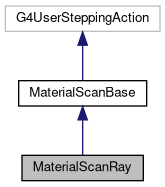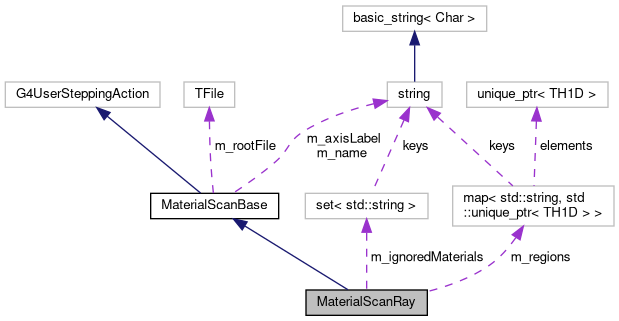 |
Belle II Software
release-08-01-10
|
 |
Belle II Software
release-08-01-10
|
MaterialScan implementation to shoot one ray along a defined direction and record the Material as a function of travel depth. More...
#include <MaterialScan.h>


Public Member Functions | |
| MaterialScanRay (TFile *rootFile, const G4ThreeVector &origin, const G4ThreeVector &dir, double opening, int count, double sampleDepth, double maxDepth, bool splitByMaterials, const std::vector< std::string > &ignoredMaterials) | |
| Construct a new instance and set all parameters. | |
| int | getNRays () const override |
| Return the number of rays. More... | |
| void | UserSteppingAction (const G4Step *step) override |
| Record the material budget for each step of the particles. | |
| bool | createNext (G4ThreeVector &origin, G4ThreeVector &direction) override |
| Implement shooting along the ray. | |
| std::string | getName () const |
| Return the name of the scan. | |
Protected Member Functions | |
| bool | checkStep (const G4Step *step) |
| check for stuck tracks by looking at the step length | |
Protected Attributes | |
| TFile * | m_rootFile |
| Pointer to the root file for the histograms. | |
| std::string | m_name |
| Name of the scan, will be prefixed to all histogram names. | |
| std::string | m_axisLabel |
| Labels for the coordinate axes. | |
Private Member Functions | |
| TH1D * | getHistogram (const std::string &name) |
| get histogram for a given name, create if needed. More... | |
| void | fillValue (const std::string &name, double value, double steplength) |
| Fill the recorded material budget into the corresponding histogram. More... | |
Private Attributes | |
| std::set< std::string > | m_ignoredMaterials |
| Materials ignored when scanning. | |
| std::map< std::string, std::unique_ptr< TH1D > > | m_regions |
| Map holding pointers to all created histograms. | |
| G4ThreeVector | m_origin |
| Origin of the scan. | |
| G4ThreeVector | m_dir |
| Direction of the ray. | |
| double | m_opening |
| Opening angle in radian. | |
| double | m_sampleDepth |
| The ray length after which to sample. More... | |
| double | m_maxDepth {0} |
| Maximum depth for each ray after which it will be stopped. More... | |
| double | m_curDepth {0} |
| Current depth of the current ray. | |
| double | m_scanDepth {0} |
| The first ray does not record any material but just checks for the maximum useful depth to not get a plot which contains the PXD at the front and then continues for 500 more cm without any content. More... | |
| int | m_count |
| Amount of rays to shoot. | |
| int | m_curRay { -1} |
| Current Ray number: 0 = scan for maximum depth, 1..N = record materials. | |
| bool | m_splitByMaterials |
| If true Split by materials instead of regions. | |
| int | m_zeroSteps {0} |
| Count the number of steps with (almost) zero length. | |
Static Private Attributes | |
| static constexpr double | c_zeroTolerance = 1e-6 |
| maximum Step length to be considered zero | |
| static constexpr int | c_maxZeroStepsNudge = 10 |
| maximum number of consecutive zero steps before nudging the track along | |
| static constexpr int | c_maxZeroStepsKill = 20 |
| maximum number of consecutive zero steps before killing the track | |
MaterialScan implementation to shoot one ray along a defined direction and record the Material as a function of travel depth.
In contrast to the other implementations this produces a 1D histogram per region (plus a cumulative one) which contains the X_0 per bin so that the integral of the histogram ( ![]() ) is equal to the total number of X_0 seen.
) is equal to the total number of X_0 seen.
Definition at line 239 of file MaterialScan.h.
|
private |
Fill the recorded material budget into the corresponding histogram.
| name | Name of the histogram |
| value | Value to store |
| steplength | The Steplength which produced the value (for correct subsampling) |
Definition at line 266 of file MaterialScan.cc.
|
private |
get histogram for a given name, create if needed.
| name | Name of the histogram |
Definition at line 254 of file MaterialScan.cc.
|
inlineoverridevirtual |
Return the number of rays.
We have one extra ray to scan the maximum depth
Implements MaterialScanBase.
Definition at line 254 of file MaterialScan.h.
|
private |
Maximum depth for each ray after which it will be stopped.
0=no limit.
Definition at line 284 of file MaterialScan.h.
|
private |
The ray length after which to sample.
Basically the bin width of the histogram
Definition at line 282 of file MaterialScan.h.
|
private |
The first ray does not record any material but just checks for the maximum useful depth to not get a plot which contains the PXD at the front and then continues for 500 more cm without any content.
This variable stores the maximum depth seen by this ray in non-ignored matierals
Definition at line 292 of file MaterialScan.h.